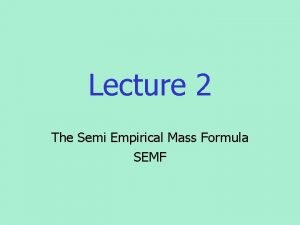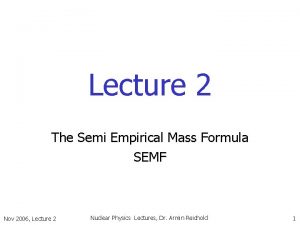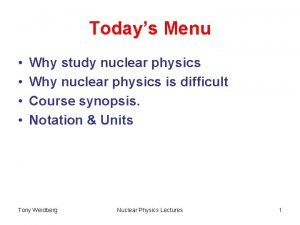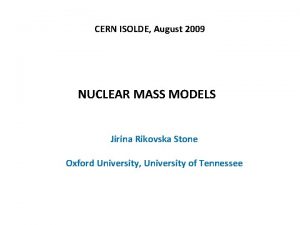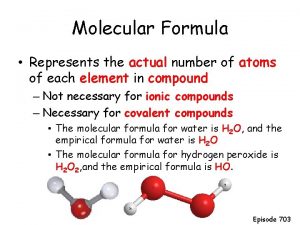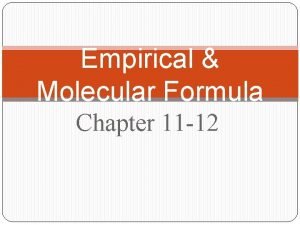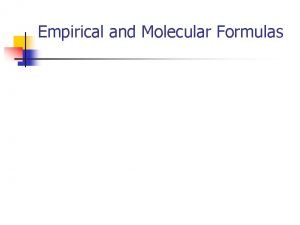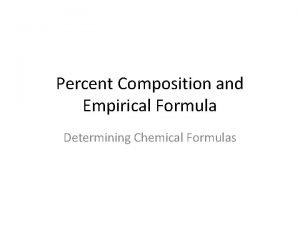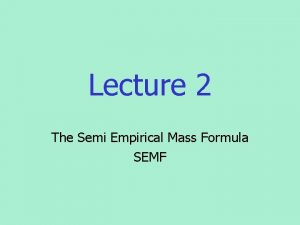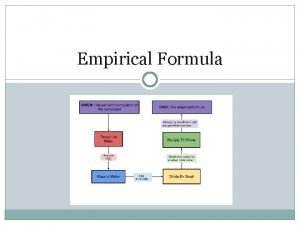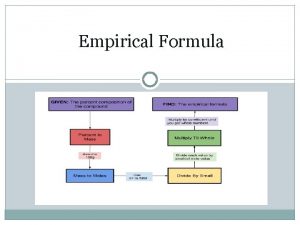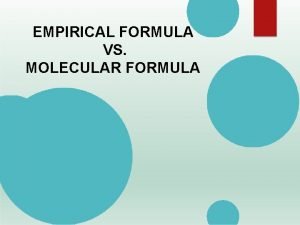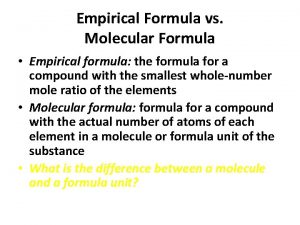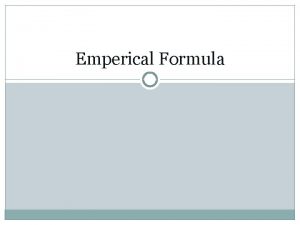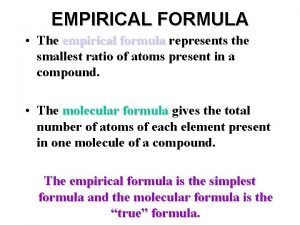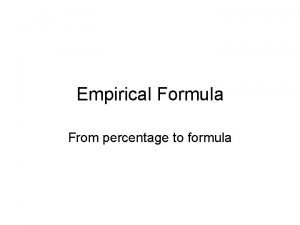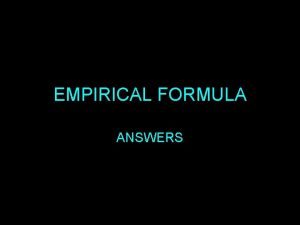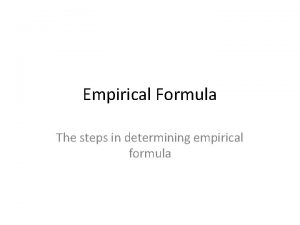Lecture 2 The Semi Empirical Mass Formula SEMF



















- Slides: 19

Lecture 2 The Semi Empirical Mass Formula SEMF

2. 0 Overview n n n n 2. 1 The liquid drop model 2. 2 The Coulomb Term 2. 3 Mirror nuclei, charge asymmetry and independence 2. 4 The Volume and Surface Terms 2. 5 The asymmetry term 2. 6 The pairing term 2. 7 The SEMF

2. 0 Introduction to the SEMF n n Aim: phenomenological understanding of nuclear binding energies as function of A, Z and N. Assumptions: n n n Nuclear density is constant (see lecture 1). We can model effect of short range attraction due to strong interaction by a liquid drop model. Coulomb corrections can be computed using electro magnetism (even at these small scales) Nucleons are fermions at T=0 in separate wells (Fermi gas model asymmetry term) QM holds at these small scales pairing term. Compare with experiment: success & failure!

2. 1 Liquid Drop Model Nucleus n n Phenomenological model to understand binding energies. Consider a liquid drop n n Ignore gravity and assume no rotation Intermolecular force repulsive at short distances, attractive at intermediate distances and negligible at large distances constant density. n=number of molecules, T=surface tension, B=binding energy E=total energy of the drop, a, b=free constants E=-an + 4 p. R 2 T n Analogy with nucleus n n B=an-bn 2/3 surface area ~ n 2/3 Nucleus has constant density From nucleon-nucleon scattering experiments we know: n n Nuclear force has short range repulsion and is attractive at intermediate distances. Assume charge independence of nuclear force, neutrons and protons have same strong interactions check with experiment (Mirror Nuclei!)

2. 2 Coulomb Term n n The nucleus is electrically charged with total charge Ze Assume that the charge distribution is spherical and compute the reduction in binding energy due to the Coulomb interaction to change the integral to dr ; R=outer radius of nucleus … and remember R=R 0 A 1/3 includes self interaction of last proton with itself. To correct this replace Z 2 with Z*(Z-1) in principle you could take d from this calculation but it is more accurate to take it from the overall fit of the SEMF to data (nuclei not totally spherical or homogeneous)

2. 3 Mirror Nuclei n n Does the assumption of the drop model of constant binding energy for every constituent of the drop actually hold for nuclei? Compare binding energies of mirror nuclei (nuclei with n p). E. g. 73 Li and 74 Be. If the assumption holds the mass difference should be due to n/p mass difference and Coulomb energy alone. Let’s compute the Coulomb energy correction from results on previous page to find that n n Now lets measure mirror nuclei mass, assume that the model holds and derive DECoulomb from the measurement. This should show an A 2/3 dependence And the scaling factor should yield the correct R 0 of 1. 2 fm if the assumptions were right

2. 3 “Charge symmetry” nn and pp interaction same (apart from Coulomb)

2. 3 More charge symmetry n n Energy Levels of two mirror nuclei for a number of excited states Corrected for n/p mass difference and Coulomb Energy Ecorrected

2. 3 From Charge Symmetry to Charge Independence n n n Mirror nuclei showed that strong interaction is the same for nn and pp. What about np ? Compare energy levels in “triplets” with same A, different number of n and p. e. g. If we find the same energy levels for the same spin states Strong interaction is the same for np as nn and pp. See next slide

2. 3 Charge Independence n n n Same spin/parity states should have the same energy. Yes: np=nn=pp Note: Far more states in 22 Na. Why? 11 Because it has more np pairs than the others np pairs can be in any Spin-Space configuration Note also that 2211 Na has the lowest (most bound) state, remember for the deuteron on next page Ecorrected 22 10 Ne 22 22 11 Na 12 Mg

2. 3 Charge Independence n We have shown by measurement that: n n If we correct for n/p mass difference and Coulomb interaction, then energy levels in nuclei are unchanged under n p and we must change nothing else! I. e. spin and space wavefunctions must remain the same! Conclusion: strong two-body interaction same for pp, pn and nn if nucleons are in the same quantum state. Beware of the Pauli exclusion principle! e. g. why do we have bound state of pn but not pp or nn? n n because the strong force is spin dependent and the most strongly bound spin-space configurations (deuteron) are not available to nn or pp. It’s Her Pauli again! Just like 2211 Na on the previous triplet level schema

2. 4 Volume and Surface Term n We now have all we need to trust that we can apply the liquid drop model to a nucleus n n n constant density same binding energy for all constituents Volume term: Surface term: Since we are building a phenomenological model in which the coefficients a and b will be determined by a fit to measured nuclear binding energies we must include any further terms we may find with the same A dependence together with the above

2. 5 Asymmetry Term n n Neutrons and protons are spin ½ fermions obey Pauli exclusion principle. If all other factors were equal nuclear ground state would have equal numbers of n & p. neutrons protons n n n Illustration n and p states with same spacing . Crosses represent initially occupied states in ground state. If three protons were turned into neutrons the extra energy required would be 3× 3 . In general if there are Z-N excess protons over neutrons the extra energy is ((Z-N )(Z-N) ).

2. 5 Asymmetry term n From the Fermi Gas model we know that n n due to the fermionic nature of p and n we loose in binding energy if the nucleus deviates from N=Z The Asymmetry term:

n n Observations: Nuclei with even number of n or even number of p more tightly bound than with odd numbers. See figure Only 5 stable o-o nuclei but 201 stable e-e nuclei. Two p or two n in same energy level with opposite values of jz have AS spin state 2. 6 Pairing Term Neutron separation energy [Me. V] in Ba isotopes 138 forced into sym spatial w. f. maximum overlap maximum binding energy because of short range attraction. Note: this only holds for nn and pp, not for np. We don’t have a preference for even A Neutron number 56 Ba

2. 6 Pairing Term n n Measure that the Pairing effect smaller for larger A Phenomenological*) fit to A dependence gives A-1/2 e-e e-o o-o d +ive 0 -ive Note: If you want to plot binding energies versus A it is often best to use odd A only as for these the pairing term does not appear

2. 7 Semi Empirical Mass Formula n Put everything together: Volume Surface Term n n Asymmetry Term Coulomb Term Pairing Term Lets see how all of these assumptions fit reality And find out what the constants are 2 n Note: we went back to the simpler Z instead of Z*(Z-1)

2. 7 Semi Empirical Mass Formula Binding Energy vs. A for beta-stable odd-A nuclei Iron Fit parameters in Me. V a 15. 56 Not smooth because Z not smooth function of A b 17. 23 c 23. 285 d 0. 697 d +12 (o-o) d 0 (o-e) d -12 (e-e)

2. 7 Semi Empirical Mass Formula n Conclusions n n n Only makes sense for A≥ 20 Good fit for large A (good to <1%) in most places. Deviations are interesting shell effects. Coulomb term constant agrees with calculation. Explains the valley of stability (see next lecture). Explains energetics of radioactive decays, fission and fusion.
 Asymmetry term semi-empirical mass formula
Asymmetry term semi-empirical mass formula Semi empirical mass formula
Semi empirical mass formula Mass mole
Mass mole Formula mass vs gram formula mass
Formula mass vs gram formula mass How to get empirical formula from percentages
How to get empirical formula from percentages Semi emperical mass formula
Semi emperical mass formula Semi emperical mass formula
Semi emperical mass formula Empirical formula vs molecular formula
Empirical formula vs molecular formula How to calculate empirical formula using percentages
How to calculate empirical formula using percentages Definition of molecular formula
Definition of molecular formula Molecular formula from empirical formula
Molecular formula from empirical formula Site:slidetodoc.com
Site:slidetodoc.com Empirical formula chemistry
Empirical formula chemistry Chapter 7 chemical formulas and chemical compounds test
Chapter 7 chemical formulas and chemical compounds test Empirical formula rhyme
Empirical formula rhyme Molecular formula of ch
Molecular formula of ch Compound ratio
Compound ratio 01:640:244 lecture notes - lecture 15: plat, idah, farad
01:640:244 lecture notes - lecture 15: plat, idah, farad Ideal stoichiometric calculations
Ideal stoichiometric calculations Percent mass formula
Percent mass formula
